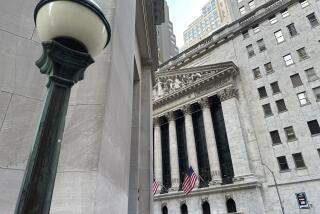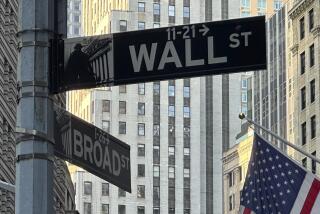Bond Yields Hit 2-Year Highs
A robust retail sales report for May sent Treasury bond yields soaring to fresh two-year highs Monday, in turn triggering a broad decline in stocks.
The Dow Jones industrial average fell 75.37 points, or 0.7%, to 10,334.73, though it pulled up from deeper losses.
Some investors were fearing more selling in bonds and stocks today, when the government reports on May consumer prices. Federal Reserve Chairman Alan Greenspan warned last week that a sustained pickup in inflation could force the central bank to abandon its plan to tighten credit at a “measured” pace.
On Monday, the Commerce Department said retail sales jumped 1.2% in May, indicating consumers’ hunger for a wide variety of goods.
That stoked fears that the Fed might be compelled to raise its benchmark short-term interest rate a half percentage point when policymakers meet June 29 and 30.
Wall Street has widely been expecting a quarter-point rate hike. The Fed’s key rate now is 1%, a generational low.
“The benign pace of rates the market has discounted may not be the case now,” said Russ Koesterich, equity strategist at State Street Corp. in Boston.
“From the Fed’s perspective this is clearly just another reason why they can start raising rates and want to keep the option of being more aggressive,” Dominic Konstam, head of interest-rate strategy at Credit Suisse First Boston in New York, told Bloomberg News.
The yield on the 10-year Treasury note rose to 4.87% on Monday from 4.8% on Thursday, and now is the highest since June 2002. (Financial markets were closed Friday in observance of former President Reagan’s funeral.)
Yields on shorter-term bonds rose more sharply. Shorter-term securities are more sensitive to changes in the Fed’s key rate.
The rate on the two-year T-note ended at 2.93%, up from 2.8% on Thursday and also the highest since June 2002. The two-year note rate has jumped nearly a half percentage point since May 26. It began the year at 1.82%.
Greenspan last week appeared to be trying to prepare investors for a faster pace of rate increases. On Monday, Fed Gov. Mark Olson said the central bank needed to be “alert to inflationary pressures.” He made his comments in response to questions after a speech.
For much of this year the stock market has been torn between the good news of a strong economy and the bad news of rising rates. In recent weeks the market has rallied even as bond yields have jumped. Through Thursday the Dow index had risen 504 points since May 17.
But profit takers dominated in Monday’s session. The Dow was down 103 points at its low before rallying in the final half-hour of trading.
The Nasdaq composite index slumped 29.88 points, or 1.5%, to 1,969.99.
The Standard & Poor’s 500 index dropped 11.18 points, or 1%, to 1,125.29.
Falling stocks outnumbered winners by more than 4 to 1 on the New York Stock Exchange and by about 3 to 1 on Nasdaq. Trading was moderate.
Lower oil prices failed to cheer Wall Street: Near-term crude oil futures continued to slide, dropping 86 cents to $37.59 a barrel in New York, as rising fuel supplies in the United States soothe fears of a summer gasoline crunch.
Standard & Poor’s advised clients Monday to be more cautious about stocks. The firm reduced its recommended portfolio allocation to 50% U.S. stocks, down from 55%, and to 10% non-U.S. stocks, down from 15%. S&P; recommended raising cash holdings to 30% of a portfolio, up from 20%, and held its bond allocation steady at 10%.
Among Monday’s market highlights:
* Financial and construction stocks led the market lower on concerns about interest rates.
Bank of America lost $1.66 to $82.55, Comerica slid $1.33 to $55.14 and Merrill Lynch fell $1.09 to $55.77.
In the housing sector, Ryland dropped $2.84 to $74.55 and KB Home fell $1.67 to $61.62.
* Technology stocks were broadly lower. The Bloomberg Silicon Valley index shed 1.6%, with all 34 stocks declining. The index is down 4.7% this year after gaining 52% in 2003.
* City of Commerce-based 99 Cents Only Stores topped percentage losers on the NYSE, sinking 31% to a 52-week low after the firm Friday slashed profit forecasts because of problems related to inventory controls and rising costs. The stock plunged $6.38 to $14.10. Merrill Lynch & Co. analyst Daniel Barry cut his rating on the company’s shares to “sell” from “neutral.”
* Most retail shares were lower despite the government’s May sales report. Wal-Mart Stores said sales gains this month were meeting the company’s expectations. Sales are on pace to rise at least 4%, as shoppers buy more food, toys and pet supplies, the firm said. Wal-Mart eased 82 cents to $56.38.
* R.J. Reynolds Tobacco jumped $2.75, or 4.8%, to $59.59, for the S&P; 500’s biggest gain. The company said its proposed $3-billion acquisition of Brown & Williamson Tobacco should be approved without forcing it to divest businesses.
* Atrix Laboratories soared $3.37 to $31.39. QLT, maker of the Visudyne drug for eye degeneration, agreed to buy Atrix for $855 million in stock and cash to add products for prostate cancer and acne. QLT will swap one of its shares and $14.61 in cash for each Atrix share. QLT sank $3.47 to $17.55.
More to Read
Inside the business of entertainment
The Wide Shot brings you news, analysis and insights on everything from streaming wars to production — and what it all means for the future.
You may occasionally receive promotional content from the Los Angeles Times.









